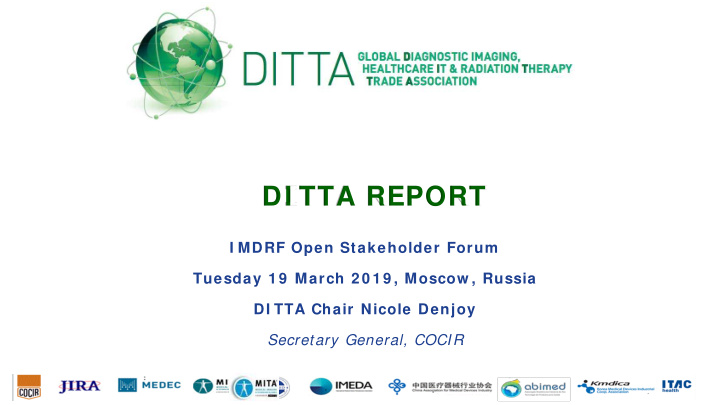



DI TTA REPORT I MDRF Open Stakeholder Forum Tuesday 1 9 March 2 0 1 9 , Moscow , Russia DI TTA Chair Nicole Denjoy Secretary General, COCIR
DITTA is a non-profit trade association, created in 2000 and incorporated in 2012 represents more than 600 companies around the globe DITTA covers the following industry sectors: 1. Diagnostic imaging, 2. Radiation therapy, 3. Healthcare IT, 4. Electromedical 5. and Radiopharmaceuticals Our Industry leads in state-of-art advanced technology and provides integrated solutions covering the complete care cycle Hospital Government Polyclinic Cen Hom tral e Pati Pharmacy ent’ s EHR Laboratory
DITTA GLOBAL PRESENCE
DITTA: 9 WORKING GROUPS Regulated Product Subm ission ( RPS) 1. W orking Group Medical Device Single Audit Program ( MDSAP) W orking Group 2. Unique Device I dentification ( UDI ) 3. W orking Group Standardisation ( STA) W orking Group 4. Clinical Evaluation 5. Global Health ( GH) W orking Group 6. Environm ental Policy ( ENVI ) W orking Group 7. Good Refurbishm ent Practice ( GRP) 8. W orking Group 9. Cybersecurity W orking Group
DITTA feedback on IMDRF Topics: 1. Cybersecurity 2. Unique Device Identification (UDI) 3. Clinical Evaluation 4. Standards 5. Medical Device Single Audit Program (MDSAP) 6. Regulated Product Submission (RPS)
KEY POINTS (1) 1 . Cybersecurity 1. Recognize that cybersecurity is a shared responsibility among all stakeholders 2. Promote broad information sharing policies 3. Consistent definition of terms and clarify the current understanding on medical device cybersecurity 4. Promote convergence of cybersecurity requirements along the device life- cycle across jurisdictions 5. Promote MDS2* as form for industry to document and communicate medical device security features 6. Ensure consistency with the newly adopted Essential Principles 2 . Unique device identifier ( UDI ) 1. Strongly support continuation of the work on UDI, including adoption of the NWIP 2. Ensure consistent implementation of UDI globally 3. Emphasize commonality for key aspects of a UDI system *MDS2 = Manufacturer Disclosure Statement for Medical Device Security
KEY POINTS (2) 3 . Clinical Evaluation 1. Accept clinical trial data from other jurisdictions based on common criteria 2. Accept clinical investigations based on device characteristics 3. Support endorsing the draft guidance documents for public consultation 4 . Standards 1. Support the NWIP on SOPs to lead to a framework that operationalises the IMDRF liaison to ISO and IEC 2. Ensure the implementation of the guidance on optimizing standards for regulatory use 3. Align mechanisms for recognition of standards across jurisdictions
OUTCOMES OF IMDR-DITTA WORKSHOP ON STANDARDS Goal: to explore how regulators and standards developers will use the recommendations of the IMDRF guidance at a practical level. In addition, learn more on the next steps for the IMDRF WG and its activities on standardization. Information will also be shared on specific standardization activities in IEC and ISO. Attendance: over 200 participants Speakers: 8 from regulators from 5 jurisdictions (EC/Germany, China, Japan, Russia, USA), 4 from industry (Japan, EU, Russia), 1 from IEC Key Take Aways: • Get latest updates on the progress of the IMDRF WG on standards Advance harmonized use of standards in regulatory frameworks • • Build productive relationships between IMDRF and ISO/IEC through category A liaison program towards concrete operationalization • Long term goal being towards consistency in conformity assessment approaches
KEY POINTS (3) 5 . MDSAP 1. Continuing strong industry support for MDSAP programme 2. Support current grading system but recommend continuous refinement 3. On-going concerns about AO interpretation, expertise, and capacity 6 . Regulated Product Subm ission ( RPS) 1. Recognize the value of a globally harmonized ToC as a foundation to support a future global single submission format 2. Support focus on ToC stabilization and implementation
CONCLUSIONS 1 . Cybersecurity – Support convergence of understanding and requirements on cybersecurity 2 . UDI – Support consistent global implementation 3 . Clinical Evaluation – Support endorsing the draft guidance documents for public consultation 4 . Standards – Support the NWIP on SOPs to lead to a framework that operationalises the IMDRF liaison to ISO and IEC 5 . MDSAP – Continuing strong industry support for MDSAP programme 6 . RPS – Support focus on ToC stabilization and implementation
THANK YOU! СПАСИБО! www.globalditta.org Follow us on @DITTA_online Nicole Denjoy – denjoy@globalditta.org
Recommend
More recommend